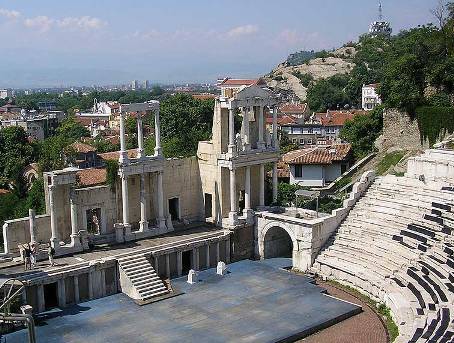

Location: Plovdiv
Ancient theatre of Plovdiv is one of the easily recognizable symbols of the city that is located in the Old Town region. This magnificent ancient structure was erected in the time of reign (98- 117 AD) of Emperor Trajan back then Plovdiv was known as Philippopolis. In the 5th century AD the settlement was sacked by the barbarian tribe of Huns under leadership of Attila. They destroyed many buildings and greatly damaged ancient theatre. Its ruins were discovered by chance: the specialists of the Archaeological Museum carried out work here to strengthen the fortress wall. This is the only case when in Plovdiv not individual fragments were discovered, but the whole object. It took almost 10 years to dig up the ancient theater, which was under a 15-meter layer of earth. Despite the fact that once the complex was significantly damaged, today it is one of the best-preserved buildings of this type in the world.
The seats of the spectators were oriented to the
south, towards the ancient city and towards the foothills of the Rhodope
Mountains. From the ground plan, the theater is a semicircle with an
outer diameter of 82 meters.
The open spectator area (Cavea)
included 28 concentric rows with marble seats (20 of which have remained
intact), which were divided into two levels by a corridor (diazoma). The
upper level is interrupted by narrow, radially running stairs. These
seven staircases divide the spectator area into six wedge-shaped sectors
(Kerkides = wedge fields). The audience seats surround the stage
(orchestra), which has a horseshoe-shaped floor plan and a diameter of
26.64 meters.
The stage building, the Skene, is located south of
the orchestra and has three floors. The stage area, Proscenium, is 3.15
m high and its facade facing the orchestra is designed with ionic marble
columns and a pediment (pediment triangle). The facade of the Skene,
which overlooks the auditorium, consists of a two-story portico
(portico), the first of which is executed in Ionic order and the second
in Roman-Corinthian order. The facade is intersected by three
symmetrically arranged gates.
The entrance to the Orchestra
(Parodos), which was not originally covered and was only covered later,
connects the cavea with the stage building. An underground archway
starts in the middle of the orchestra and leads out of the theatre under
the stage building. Another corridor runs under the central bench of the
seating area of the upper level and connects the Cavea with the area of
the three Hills (Trimontium = City of the Three Hills). Across the aisle
was the box for the dignitaries.
Similar to all other theaters in
the Roman Empire, the honorary seats of the theater in Philippopolis
bore an inscription. There were inscriptions for the representatives of
the city, but also for the magistrate and the friends of the emperor.
Some honorary inscriptions show that the building was also used as the
seat of the Thracian Provincial Assembly.
Probably, gladiatorial
fights against wild animals were also held in the theater, which is
indicated by the remains of security facilities in front of the first
row of spectators. These additional measures were taken because of the
visit of Emperor Caracalla to Philippopolis in 214 AD.
The
restoration of the Roman Theater in Plovdiv was a great achievement of
the Bulgarian conservators. The reconstruction was carried out strictly
according to the rules of anastilosis, with the newly added building
material being clearly distinguishable. Now the theater and the
Three-hill area (Trimontium) is one of the symbols of the city of
Plovdiv, and classical dramas, dances and music are performed on its
stage.
There are several steles and wall inscriptions in Greek in
the theater.
The theater was built with a capacity of 7000
spectators. each section bears the name of a district of the city, which
is engraved on the seats, so that the spectators of that time knew their
place.
At the end of the 4th century, much of the theater was
destroyed by a fire or an earthquake. During this time, the whole region
was devastated by the Hun invasions.
After a landslide, the
theater was discovered and explored by the Plovdiv Archaeological Museum
during archaeological excavations in the years 1968 to 1979. During the
excavations, among other things, a 4.5-meter-thick layer of earth had to
be removed.
During the summer months, regular theatre and music performances take place in the theatre, including the annual Plovdiv International Folklore Festival. The award ceremony for the 21st International Computer Science Olympiad 2009 took place in this theater.